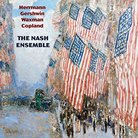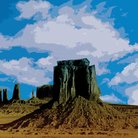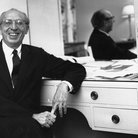Great Composers - Aaron Copland
At a time when Europeans dominated the classical scene, Aaron Copland succeeded in establishing American music as a force to be reckoned with.
Who was he? America’s most celebrated classical composer
Why is he important? He single-handedly gave American classical music its own distinctive voice and popular appeal
What are his most famous works? Fanfare For The Common Man; Rodeo; Appalachian Spring; Billy The Kid; El Salón México
Aaron Copland is widely celebrated as the “Dean Of American music”, and with good reason. Until he burst onto the scene in the 1920s, American classical music had struggled to find its own authentic voice.
Such composing worthies as John Knowles Paine, Amy Beach, Edward MacDowell and Horatio Parker had consciously fashioned their music on the European Romantic tradition. The iconoclastic genius Charles Ives had been the first to make the break, but despite his frequent use of indigenous American material, his no-holds-barred approach to composing was certainly not for the faint-hearted.
George Gershwin had already achieved massive popularity through his songs and shows, but his was the music of the gifted street musician rather than the academic conservatoire pupil.
Due to the worsening political situation in Europe, a number of composing émigrés had made their way across the Atlantic to the New World, most notably Rachmaninov. This spurred North American composers to redouble their efforts to develop a distinctive, national style.
The way was clear for a creative voice to emerge that would draw together the various strands of American popular and folk music for concert-hall presentation, and Copland proved to be the right person in the right place at the right time.
As he memorably put it, “The prospect of having to sit through one of Rachmaninov’s extended symphonies or piano concertos tends, quite frankly, to depress me. All those notes, and to what end?”
Copland’s early musical training was thoroughly conventional. His singer-pianist mother prescribed a healthy diet of opera, ballet and orchestral concerts in addition to piano and violin lessons, but it was not until he saw the great Polish pianist-composer Paderewski give a sensational recital in 1915 that he fixed his sights on becoming a composer.
Two years later he began lessons with Rubin Goldmark, who ensured that Copland was brought up to speed with the music of the great Romantic masters. However, Copland was already hankering after something more stylistically adventurous, as witness the Debussyian heartbeat of his first published composition, The Cat And The Mouse (1920) for solo piano.
Now there was simply no holding him back. Between 1921 and 1924 Copland bathed in the artistic hot-spring that was post-war Paris, under the intellectually bracing guidance of Nadia Boulanger. Having absorbed everything from Ravel and Satie to Proust and Picasso, Copland returned home determined to put the United States on the musical map once and for all.
At first things did not go at all well. His Piano Concerto’s blazing fusion of jazz and Stravinsky proved too much for the 1927 premiere’s Boston audience.
“They called me an ogre,” Copland despaired. “They even claimed that the conductor Koussevitzky had programmed it with the malice of a foreigner who wanted to show how bad American music is.”
However, this did little to dampen his enthusiasm, and under the influence of the tireless artistic promoter Alfred Stieglitz he formed what he called a “commando unit” of American composers at the vanguard of contemporary thinking with Roy Harris, Walter Piston, Roger Sessions and Virgil Thompson.
Via such strikingly inventive scores as the Symphonic Ode (1927-29), Piano Variations (1930) and Statements For Orchestra (1932-35) Copland attempted to establish a more objective aesthetic, yet this had the unintended effect of alienating the very audiences that he wanted to attract.
“During these years,” he later reflected, “I began to feel an increasing dissatisfaction with the relations of the music-loving public and the living composer. It seemed to me that living composers were in danger of living in a vacuum. I felt that it was worth the effort to see if I could say what I had to say in the simplest possible terms.”
This change of creative stance, inspired in part by the German Gebrauchsmusik (“utility music”) movement, was to bear instant fruit in a work that established Copland’s popular reputation at a stroke: his foot-tapping orchestral fantasy El Salón México (1933-36). As a direct result of the work’s overwhelming success, Copland won a permanent contract with the leading music publisher Boosey & Hawkes.
From contemporary Latin America, Copland moved back in time to the Wild West for his ballet score Billy The Kid (1938). Incorporating cowboy songs, the result is like an American Peter And The Wolf (Prokofiev’s masterwork was then just two years old), but with choreography in place of narration.
Such was the impact of Billy The Kid that the Ballet Russes De Monte Carlo commissioned a follow-up cowboy ballet in the form of Rodeo (1942).
Described by Copland as encapsulating “the problem that has confronted every American woman from earliest pioneer times, and which has never ceased to occupy them throughout the history of the building of our country: how to get a suitable man”, the premiere was greeted with a staggering 22 curtain calls.
That same year Copland produced two works designed specifically to raise the morale of America’s armed forces as they entered the Second World War: Lincoln Portrait for narrator and orchestra; and Fanfare For The Common Man, modestly described by Copland as “a traditional fanfare, direct and powerful, yet with a contemporary sound”, which was destined to become his most popular work.
Copland had effectively become “the voice of American music” by the time Martha Graham asked him to compose a ballet with the enigmatic title of Appalachian Spring early in 1943.
The scenario is the simple presentation of a Pennsylvania homecoming party in the Appalachian Mountains for a man and his bride in pioneer time. From this simple tale Copland spins a web of glowingly inspired music unmistakably suggestive of America’s vast rolling landscapes.
Following the 1944 premiere of Appalachian Spring, Copland found himself on the crest of a wave of public recognition. The original chamber version of the score won the New York Critics’ Circle Award in 1945, and his full symphony orchestra arrangement was rewarded with the prestigious Pulitzer Prize for Music.
By now Copland had successfully branched out into other fields of creative endeavour. His film scores for Of Mice And Men (1939), Our Town (1940) and The North Star (1943) had received Academy Award nominations (he went on to win an Oscar in 1950 for The Heiress), and for the “entirely new public” of the radio, Copland had written three pieces: Music For Radio (1937), the railroad ballad John Henry (1940), and Letter From Home (1944).
His books What To Listen For In Music (1939) and Our New Music (1941) had become bestsellers, and he was in great demand as one of America’s most respected music lecturers and educators, most notably as head of the composition department at Tanglewood’s Berkshire Music Center between 1940 and 1965.
Over time, Copland’s extracurricular commitments began to take precedence over his composing, until by the early 1970s the flow of new music had slowed to a mere trickle.
“It was exactly as if someone had simply turned off a faucet,” he lamented.
Just as his creative powers began waning in the 1960s so Copland discovered the joys of conducting as never before, and, although largely self-taught and lacking in virtuoso technique, he made such an impact that invitations to direct his own music began arriving from around the globe. Meanwhile, record label CBS (now Sony/BMG) grasped the opportunity to record virtually all of his orchestral music for posterity.
Copland made his last public appearance in 1983, after which his health began to deteriorate owing to the onset of Alzheimer’s disease. He died shortly after his 90th birthday, on December 2 1990, leaving behind a considerable personal fortune, much of which was bequeathed to the setting up of a Fund for Music.
In 2008 alone, the Fund awarded around £410,000 to 83 organisations dedicated to the commissioning and performance of American contemporary music.
“If forced to explain the creative musician’s basic objective in elementary terms,” Copland wrote in the 1949 Christmas Day edition of the New York Times, “I would say that a composer writes music to express and communicate and put down in permanent form certain thoughts, emotions and states of being. The resultant work of art should speak to the men and women of the artist’s own time with a directness and immediacy of communicative power that no previous art expression can give.”
Few could doubt that he succeeded in his mission.





